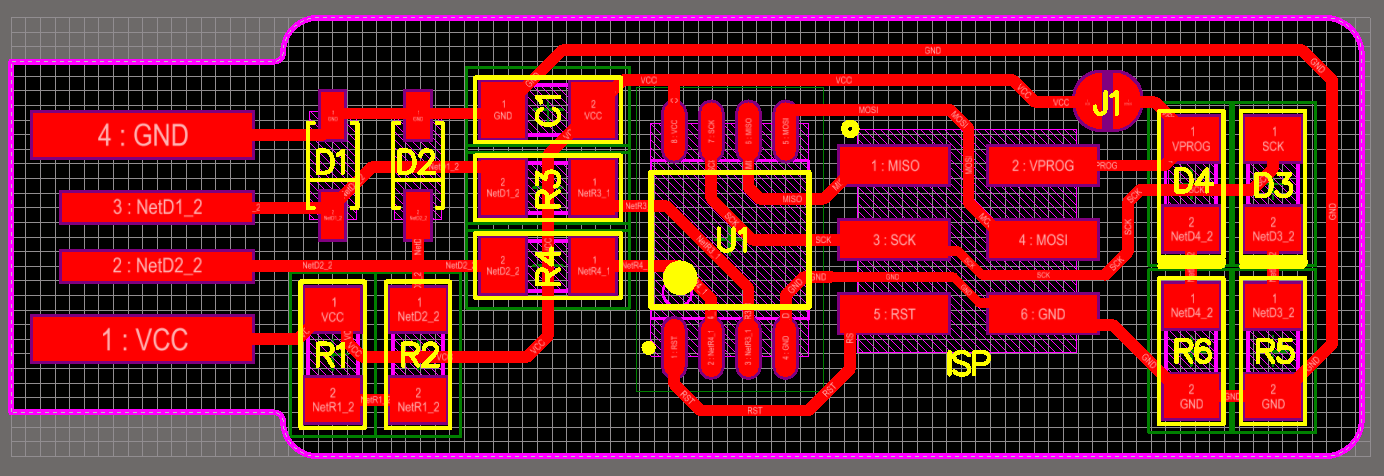This is a work in progress of developing a permanent board for my Drumdraad collection.
https://docs.arduino.cc/built-in-examples/digital/toneMultiple https://forum.arduino.cc/t/attiny-and-tone/430648/4 https://stackoverflow.com/questions/50773890/creating-an-oscillating-tone-using-arduino-attiny85-and-a-simple-buzzer
First without an amplifier, next iteration is with the LM4871.
FabtinyISP programmer:

- select USBtinyISP as programmer in the Arduino IDE (port doesn’t matter)
Pinout ATTiny85:

I didn’t have space to use pins for serial communication, but if I don’t connect the speakers yet, I can use those pins instead. Or at least I tried but then I learned that I couldn’t flip the necessary switches because then I caused a short somewhere; I didn’t really look into it but I think it’s because I designed it with power from the 5V power supply in mind once the system was running. Anyway, this was my attempt with serial:
// program the board with all switches facing away from the capacitor
#include"pitches.h"
#include <SoftwareSerial.h>
// These constants won't change:
const int sensorPin1 = A2; // pin that the sensor 1 is attached to THROUGH A SWITCH
const int sensorPin2 = A3; // pin that the sensor 2 is attached to
const int speakerPin1 = A2; // pin that the speaker 1 is attached to
const int speakerPin2 = A0; // pin that the speaker 2 is attached to THROUGH A SWITCH
const int RX = 4; // used as serial pin when not connecting to speaker (A2)
const int TX = 5; // used as serial pin when not connecting to speaker (A0)
SoftwareSerial serial(RX, TX);
const int buttonPin = 0;
int lastButtonState = LOW; // the previous reading from the input pin
int sensorValue1 = 0; // the sensor value
int sensorMin1 = 1023; // minimum sensor value
int sensorMax1 = 0; // maximum sensor value
int sensorValue2 = 0; // the sensor value
int sensorMin2 = 1023; // minimum sensor value
int sensorMax2 = 0; // maximum sensor value
int buttonState; // the current reading from the input pin
// the following variables are unsigned longs because the time, measured in
// milliseconds, will quickly become a bigger number than can be stored in an int.
unsigned long lastDebounceTime = 0; // the last time the output pin was toggled
unsigned long debounceDelay = 50; // the debounce time; increase if the output flickers
int notes[] = {
NOTE_B0,
NOTE_C1,
NOTE_CS1,
NOTE_D1,
NOTE_DS1,
NOTE_E1,
NOTE_F1,
NOTE_FS1,
NOTE_G1,
NOTE_GS1,
NOTE_A1,
NOTE_AS1,
NOTE_B1,
NOTE_C2,
NOTE_CS2,
NOTE_D2,
NOTE_DS2,
NOTE_E2,
NOTE_F2,
NOTE_FS2,
NOTE_G2,
NOTE_GS2,
NOTE_A2,
NOTE_AS2,
NOTE_B2,
NOTE_C3,
NOTE_CS3,
NOTE_D3,
NOTE_DS3,
NOTE_E3,
NOTE_F3,
NOTE_FS3,
NOTE_G3,
NOTE_GS3,
NOTE_A3,
NOTE_AS3,
NOTE_B3,
NOTE_C4,
NOTE_CS4,
NOTE_D4,
NOTE_DS4,
NOTE_E4,
NOTE_F4,
NOTE_FS4,
NOTE_G4,
NOTE_GS4,
NOTE_A4,
NOTE_AS4,
NOTE_B4,
NOTE_C5,
NOTE_CS5,
NOTE_D5,
NOTE_DS5,
NOTE_E5,
NOTE_F5,
NOTE_FS5,
NOTE_G5,
NOTE_GS5,
NOTE_A5,
NOTE_AS5,
NOTE_B5,
NOTE_C6,
NOTE_CS6,
NOTE_D6,
NOTE_DS6,
NOTE_E6,
NOTE_F6,
NOTE_FS6,
NOTE_G6,
NOTE_GS6,
NOTE_A6,
NOTE_AS6,
NOTE_B6,
NOTE_C7,
NOTE_CS7,
NOTE_D7,
NOTE_DS7,
NOTE_E7,
NOTE_F7,
NOTE_FS7,
NOTE_G7,
NOTE_GS7,
NOTE_A7,
NOTE_AS7,
NOTE_B7,
NOTE_C8,
NOTE_CS8,
NOTE_D8,
NOTE_DS8,
};
void setup() {
// turn on LED to signal the start of the calibration period:
serial.begin(9600);
serial.println("Initializing...");
// pinMode(speakerPin1, OUTPUT);
// pinMode(speakerPin2, OUTPUT);
pinMode(RX, INPUT);
pinMode(TX, OUTPUT);
pinMode(sensorPin1, INPUT);
pinMode(sensorPin2, INPUT);
}
void loop() {
int reading = digitalRead(buttonPin);
// If the switch changed, due to noise or pressing:
if (reading != lastButtonState) {
// reset the debouncing timer
lastDebounceTime = millis();
}
if ((millis() - lastDebounceTime) > debounceDelay) {
// if the button state has changed:
if (reading != buttonState) {
buttonState = reading;
// only toggle the LED if the new button state is HIGH
if (buttonState == LOW) {
serial.println("start");
// determine min and max values of both sensors for 5 seconds
for (int timems = 0; timems < 5000; timems++) {
sensorValue1 = analogRead(sensorPin1);
sensorValue2 = analogRead(sensorPin2);
// record the maximum sensor value
if (sensorValue1 > sensorMax1) {
sensorMax1 = sensorValue1;
}
// record the maximum sensor value
if (sensorValue2 > sensorMax2) {
sensorMax2 = sensorValue2;
}
// record the minimum sensor value
if (sensorValue1 < sensorMin1) {
sensorMin1 = sensorValue1;
}
// record the minimum sensor value
if (sensorValue2 < sensorMin2) {
sensorMin2 = sensorValue2;
}
delay(1);
}
// serial.print("Results for sensor 1: ");
//
// serial.print(sensorMin1);
// serial.print("\t");
// serial.println(sensorMax1);
//
// serial.print("Results for sensor 2: ");
//
// serial.print(sensorMin2);
// serial.print("\t");
// serial.println(sensorMax2);
}
}
sensorValue1 = analogRead(sensorPin1);
sensorValue2 = analogRead(sensorPin2);
// serial.print(sensorValue1);
// serial.print("\t");
// serial.print(sensorValue2);
// serial.print("\t");
sensorValue1 = constrain(sensorValue1, sensorMin1, sensorMax1);
sensorValue1 = map(sensorValue1, sensorMin1, sensorMax1, 0, 300);
// serial.print("constrained and mapped:");
// serial.print("\t");
// serial.print(sensorValue1);
// serial.print("\t");
sensorValue2 = constrain(sensorValue2, sensorMin2, sensorMax2);
sensorValue2 = map(sensorValue2, sensorMin2, sensorMax2, 0, 300);
// serial.print(sensorValue2);
// serial.print("\t");
// Filtering the values by dividing by 5 then multiplying by 5
//
// serial.print("filtered:");
// serial.print("\t");
// sensorValue1 = sensorValue1 / 5;
// sensorValue1 = sensorValue1 * 5;
// serial.print(sensorValue1);
// serial.print("\t");
//
// sensorValue2 = sensorValue2 / 5;
// sensorValue2 = sensorValue2 * 5;
// serial.println(sensorValue2);
//
delay(50);
}
// save the reading. Next time through the loop, it'll be the lastButtonState:
lastButtonState = reading;
}